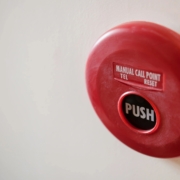Preventing Ice Dams on Homes
UNDERSTANDING HOW ICE DAMS FORM
When heat from the interior of a house with a sloped roof escapes into the attic space, it warms the underside of the roof. Meanwhile, the roof eave outside the heated space remains a colder temperature.
As snow accumulates on the rooftop, it melts over the warmer portion of the attic and the melt water runs down the roof. When it encounters the cold edge of the roof it refreezes. The refrozen water along the roof edge creates an “ice dam” and consequently, the melted snow running down the roof begins to back up underneath the roof covering. This water will soak the roof sheathing and leak into the attic unless there is a barrier above the sheathing. Sealing the roof deck is an effective way to prevent the water from entering your home and causing damage.
PREVENTING ICE DAMS
A two-step approach is the most effective way to reduce the size of ice dams. First, keep the attic floor well insulated to minimize the amount of heat from within the house that rises into the attic. Second, keep the attic well ventilated so that the cold air outside can circulate through it and reduce the temperature of the roof system. The colder the attic, the less thawing and refreezing on the roof. These two measures are the best ways to keep ice dams from increasing in size.
Step One: Insulating the attic
The attic floor should be airtight, have sufficient insulation, and keep the transfer of heat from the downstairs to the attic at a minimum. Even a well-insulated attic floor may have a number of openings that can permit warm air from below to seep up into the attic. For instance, these items may cut through the attic floor:
- exhaust pipes and plumbing vents
- fireplace and heating system c hi m n e y s
- light fixtures
Seal all openings around these penetrations, but be careful not to block attic vent s with insulation. The at tic vent s, as explained below, must be kept clear so that they can do their job. Additionally, pull-down stairs or a set of regular stairs leading up to the attic from the lower level can be avenues for rising heat. Weatherstripping around the edges of the attic access door and insulation on the attic side of the door should minimize the passage of heat to the attic. Any heat-generating equipment in the attic should be relocated.
Step Two: Ventilating the attic
There are several ways to ventilate your attic. You can do it with eave vents, soffit vents, a ridge vent, a gable vent, or some combination of these. Most modern residential roofs combine a ridge vent with soffit or eave vents. To the extent that household heat penetrates the attic, it should be able to rise and escape through, for instance, a ridge vent, while soffit or eave vents pull in cold air to replace it. Local building codes generally require a minimum level of ventilation.
Proper ventilation of the attic to let cold in, together with air sealing and insulation on the attic floor to help keep household heat out of the attic, work to minimize the likelihood of ice dams.
REMOVING ICE DAMS
IBHS does not recommend chipping or breaking ice dams due to the damage that can be inflicted on the roof. If you are not physically capable of going onto the roof or are unable to easily reach the roof, consult a roofing professional.
For low slope roofs or flat roofs:
- Removing the snow will remove the source of a potential ice dam.
- Use a heavy duty push broom with stiff bristles to brush off the snow on low slope or flat roofs.
- A shovel or snow blower should not be used since they may tear up the roof cover system.
For steep slope roofs:
- Removing the snow will remove the source of a potential ice dam.
- A roof rake may be used for most single story buildings while remaining on the ground to pull snow down the roof slope.
- Do not pull snow back against the slope or sideways since the snow may get underneath the cover and can break shingles.
Did you know that over $2 billion will be spent on Halloween candy this year? Or how about $330 million on just pet costumes?
We know that Halloween is one of children’s favorite holidays. The chance to dress up in a costume and fill bags with candy is a sure way to excite any youngster. (Plus, the fact that the average trick-or-treater consumes the equivalent of 220 packets of sugar on this holiday doesn’t hurt either.) For parents, though, the night can be a little stressful as you worry about your kids’ safety.
With that in mind, we have compiled an infographic with 31 interesting statistics and facts associated with Halloween along with a brief list of safety tips. We encourage you to take a look at it just in case there is a tip or two that will help you avoid any potential accidents or danger.
Halloween Infographic

Safety Tips
Trick-or-treating
- Make sure your children take flashlights so they can avoid tripping over obstacles on the sidewalk or in yards. Flashlights and glow sticks will also help your children be seen by motorists.
- If you allow your older kids to go out without your supervision, make sure they go out in a group. Don’t ever allow your kids to go out alone or even in pairs; make sure they go out with at least 3-4 other kids.
- Map out their route so you know where they will be and when they should be home.
- Tell your kids to only stop at familiar homes where you know the residents and where the outside lights are on.
- Instruct your kids to WALK from house to house and NEVER run.
- Make sure your kids know to never enter anyone’s home, to never accept rides from strangers, and to never take shortcuts through yards or other dimly lit areas.
Costumes
- Costumes should be light enough to be clearly visible to motorists. You may even want to add reflective tape to both your child’s costume and bag.
- Make sure your child’s costume is labeled flame-resistant.
- Costumes should be short to prevent trips and falls.
- Try cosmetic face paint rather than a mask. Masks, especially on children, may not fit properly and can obstruct vision.
- Be sure to remove all face paint that night to prevent skin irritation.
Candy
- Don’t allow your child to eat any candy before you have a chance to inspect it for choking hazards or tampering.
- Only permit your child to eat candy that is unopened in its original wrapper. Any homemade or unwrapped candy should be discarded.
- A good way to prevent your kids from eating any candy before they get home is to make sure you give them a meal or snack right before they go out.
- Above all else, limit the amount of candy your child eats after they get home or you will be dealing with one big stomachache.
Adults
- Use additional caution when driving a vehicle. Lookout for children who might run into traffic from behind parked cars or other obstacles.
- Turn on your porch and any other exterior lights to welcome trick-or-treaters to your home.
- Remove any obstacles from your lawns, steps or porches that could be a tripping hazard for children or adults.
- Keep all jack-o’-lanterns from doorsteps or steps where a child could brush by the flame with their costume.
- If you keep your jack-o’-lantern inside, place it on a sturdy table away from curtains or other ignitable decorations and out of reach from children and pets.
Thanksgiving is all about food and family – turkey, stuffing, sweet potatoes, pumpkin pie and family time. However, preparing holiday goodies can lead to disaster – the kitchen is the setting of more fires than any other room in the house, and cooking is the leading cause of fires in the home.
The following safety list was prepared by the American Red Cross to ensure a safe and happy Thanksgiving:
The cooks should start by not wearing loose clothing or dangling sleeves while cooking. Never leave cooking food unattended – stay in the kitchen when frying, grilling or broiling food. If someone must leave the kitchen for even a short period of time, they should turn off the stove. Other safety steps include:
- Check food regularly while cooking and remain in the home while cooking. Use a timer as a reminder that the stove or oven is on.
- Keep the kids away from the cooking area. Enforce a “kid-free zone” and make them stay at least three feet away from the stove.
- Keep anything that can catch fire – pot holders, oven mitts, wooden utensils, paper or plastic bags, food packaging, and towels or curtains—away from the stove, oven or any other appliance in the kitchen that generates heat.
- Clean cooking surfaces on a regular basis to prevent grease buildup.
- Purchase a fire extinguisher to keep in the kitchen. Contact the local fire department to take training on the proper use of extinguishers.
- Always check the kitchen before going to bed or leaving the home to make sure all stoves, ovens, and small appliances are turned off.
- Install a smoke alarm near the kitchen, on each level of the home, near sleeping areas, and inside and outside bedrooms. Use the test button to check it each month. Replace all batteries at least once a year.
We hope you have a happy and safe Thanksgiving!


